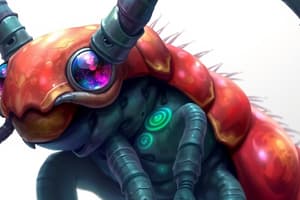Podcast
Questions and Answers
What are the characteristics of Proifera?
What are the characteristics of Proifera?
- Internal skeleton, jointed appendages
- Bilateral symmetry, segmented
- No symmetry, spongy body (correct)
- Radial symmetry, tentacles
Which of the following is an example of Cnidaria?
Which of the following is an example of Cnidaria?
- Clam
- Liver flat
- Jellyfish (correct)
- Starfish
What are the main characteristics of Echinodermata?
What are the main characteristics of Echinodermata?
Spiny skin and pentaradial symmetry
What defines the class Myriapoda?
What defines the class Myriapoda?
Which class has animals with eight legs and two main body parts?
Which class has animals with eight legs and two main body parts?
Class Mammalia is characterized by ___ or ___ and mammary glands.
Class Mammalia is characterized by ___ or ___ and mammary glands.
Nematoda includes segmented animals.
Nematoda includes segmented animals.
What type of skeleton do Chondrichthyes have?
What type of skeleton do Chondrichthyes have?
Which of the following animals belong to Class Reptilia?
Which of the following animals belong to Class Reptilia?
Match the phylum with its examples:
Match the phylum with its examples:
Flashcards are hidden until you start studying
Study Notes
Phylum Porifera
- Comprises sponges, the simplest animals, with no symmetry (asymmetrical).
- Features include porous, spongy bodies, absence of a mouth, digestive system, and nervous system, along with no segmentation.
Phylum Cnidaria
- Includes jellyfish and sea anemones, exhibiting radial symmetry.
- Characterized by tentacles and a sac-like body with one opening in the digestive tract, lacking a skeleton.
Phylum Echinodermata
- Contains starfish, sea urchins, and sand dollars, known for their spiny skin and thin exterior.
- Possesses an endoskeleton, with adults displaying pentaradial symmetry and a tubular digestive tract.
Phylum Platyhelminthes
- Encompasses liver flukes and flatworms, characterized by bilateral symmetry.
- Notable for being small, thin, and flat with a sac-like digestive system featuring one opening.
Phylum Nematoda
- Includes roundworms identified by their elongated, tubular shape.
- Displays bilateral symmetry, lack of segmentation, and a tough outer skin.
Phylum Mollusca
- Comprises clams, mussels, snails, squid, and octopuses, recognized for bilateral symmetry.
- Characterized by soft bodies, tubular digestive tracts, and most species have shells, inhabiting both land and water.
Phylum Annelida
- Includes earthworms, polychaete worms, and leeches, exhibiting bilateral symmetry.
- Known for segmented bodies and tubular digestion.
Phylum Arthropoda
- Characterized by bilateral symmetry, a hard exoskeleton, and paired jointed appendages.
Class Myriapoda
- Encompasses millipedes and centipedes, known for their long segmented bodies.
- Centipedes are predators, with bilateral symmetry.
Class Arachnida
- Includes spiders, scorpions, and ticks, with bodies divided into two main parts.
- Characterized by having eight legs, no antennae, and two mouth appendages.
Class Insecta
- Comprises praying mantises, ants, bees, butterflies, and beetles characterized by a three-part body (head, thorax, abdomen).
- Notable for six legs, two antennae, wings, bilateral symmetry, and a hard exoskeleton.
Class Crustacea
- Includes crabs, shrimp, crayfish, barnacles, and pill bugs, characterized by two main body sections (head and abdomen).
- Possesses antennae, segmented bodies, and 10-14 legs.
Phylum Chordata
- Characterized by bilateral symmetry, internal skeletons, and two pairs of jointed appendages.
Subphylum Cephalochordata
- Contains lancelets, recognized for their notochord, long body, absence of a braincase, and bilateral symmetry.
Subphylum Vertebrata
- Includes animals with vertebrates, characterized by a spinal cord, skin, two pairs of appendages, and bilateral symmetry.
Class Agnatha
- Comprises jawless fish like lampreys and hagfish, characterized by long, slender bodies and mouth tentacles.
- Features 7-15 gill slits, a tail fin, and no paired appendages.
Class Osteichthyes (Bony Fish)
- Includes all bony fish such as perch, goldfish, and rockfish, known for having jaws and a bony skeleton.
- Displays flattened or rounded scales and two pairs of fins.
Class Chondrichthyes
- Comprises skates, rays, and sharks, characterized by a cartilage skeleton and bilateral symmetry.
- Known for 5-7 gill slits and paired fins, with placoid scales.
Class Amphibia
- Includes frogs, toads, and salamanders, known for moist skin and a dual respiratory system (gills in juveniles, lungs in adults).
- Characterized by two pairs of legs and reproducing in water.
Class Reptilia
- Encompasses lizards, snakes, turtles, and alligators, recognized for dry, scaly skin.
- Features a spinal column, two pairs of legs, and lungs for respiration.
Class Aves (Birds)
- Examples include crows, swallows, and penguins, distinguished by bilateral symmetry and two pairs of appendages.
- Features include wings and feathers.
Class Mammalia
- Comprises gorillas, dolphins, and pigs, characterized by bilateral symmetry.
- Notable for possessing hair or fur and mammary glands for nursing offspring.
Studying That Suits You
Use AI to generate personalized quizzes and flashcards to suit your learning preferences.




